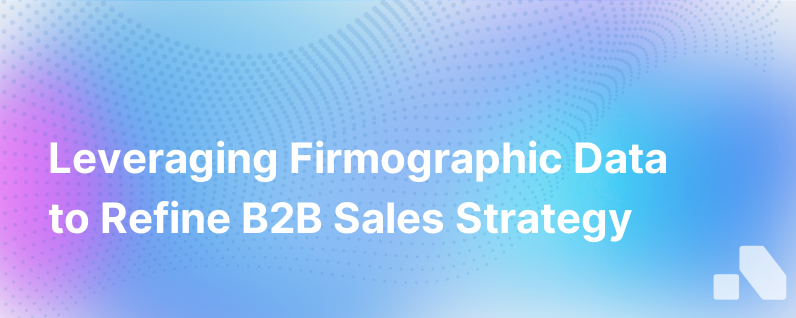Firmographic Data Examples
Published on August 11, 2023 by David Zhang
Firmographic data is the cornerstone of tailored marketing, sales strategies, and overall business analysis for B2B companies. Similar to how demographic data is used to understand individual customers, firmographics provide critical insights into organizations. In our contemporary business environment – driven by data and informed decision-making – leveraging firmographic indicators is essential for any B2B enterprise looking to gain a competitive edge.
Below, we’ll explore what firmographic data entails, its key examples, and how you can use this information to fine-tune your targeting, tailor your offerings, and fully understand your market position.
Understanding Firmographic Data
Firmographic data refers to the descriptive attributes of organizations that can be used to aggregate individual companies into meaningful market segments. It encompasses a range of quantitative and qualitative characteristics that provide a detailed overview of a company's structure and the market it operates within.
Here's why firmographic data matters:
- Strategic Targeting: It helps businesses identify their ideal customer profiles and target markets.
- Tailored Messaging: It enables personalized marketing and sales communications that resonate with specific audience segments.
- Market Analysis: It aids in understanding industry trends and patterns for better strategic planning.
Core Firmographic Data Examples
1. Company Size
Company size can be determined by the number of employees or by the company's revenue. Size is often a good indicator of a company's resources, needs, and buying capacity.
Example: If you provide enterprise-level software solutions, targeting companies with less than ten employees might not be the best strategy; instead, you'd opt for organizations with hundreds or thousands of employees and the infrastructure to support such systems.
2. Industry
The industry classification, often based on the North American Industry Classification System (NAICS) or the Standard Industrial Classification (SIC) system, tells you about the general field in which a company operates.
Example: A company classified with a SIC code that indicates they are in manufacturing may have different challenges and needs compared to one with a SIC code for retail trade, altering the services or products you would offer to each.
3. Revenue
A company's annual revenue can also play a crucial role in determining potential for sales offerings and service packages.
Example: Offering expensive, high-end business analytics platforms would be more feasible to companies that boast higher revenue numbers, as it may be inferred they have greater budgets to allocate toward such solutions.
4. Location
Geographical location can impact an organization’s operations significantly. Factors such as local economic conditions, legal requirements, and cultural influences play a role in shaping business practices.
Example: Location-based data can help global SaaS providers tailor their services to meet regional data compliance regulations like GDPR in Europe or CCPA in California.
5. Growth Rate
The growth rate can indicate a company’s stage in the business lifecycle and its openness to new investments or business solutions.
Example: A tech startup showing a 300% growth rate could be more receptive to innovative software tools that scale processes, whereas a mature enterprise with steady, single-digit growth may focus on efficiency and cost-cutting technologies.
6. Performance Metrics
Company performance indicators such as profitability, market share, or churn rate serve as a metric of business health.
Example: A company with a high churn rate might benefit from customer relationship management solutions that help them understand and mitigate customer turnover.
7. Executive Leadership
Information about a company's executive team can provide clues about their strategic direction and decision-making processes.
Example: A startup with a recently hired CTO with a background in AI might signal an upcoming focus on AI technologies, positioning your AI-based product as a timely solution.
8. Funding
For startups and emerging companies, details about funding rounds, investors, and capital raised can be pivotal information.
Example: A company that has just received Series B funding is likely scaling operations and could be in need of enhanced service platforms, HR solutions, or marketing tools to support growth.
9. Technology Stack
Understanding the software and tools a company currently uses can open conversations about integrations, replacements, or enhancements.
Example: Knowing a potential client uses a competing CRM may provide an opportunity for you to demonstrate the superior capabilities and benefits of your own CRM offering.
Utilizing Firmographic Data: Strategies for B2B Companies
Now that we’ve established examples of firmographic data, here are some strategies for putting that data to work:
Prospect and Customer Segmentation: Use firmographics to segment your market and align your sales and marketing efforts with each segment's characteristics and needs.
Personalized Marketing Campaigns: Craft personalized marketing campaigns that resonate with each segment. For instance, create tailored content highlighting how your solution overcomes specific challenges faced by businesses of a certain size or in a particular industry.
Sales Prioritization: Identify and prioritize high-potential leads with firmographic data, focusing your sales team’s energy on the most promising prospects.
Product Development and Positioning: Adjust your product offerings and messaging based on the firmographic profile of your target customers to better meet their needs.
Competitive Analysis: Understand the firmographic makeup of your competitors’ customer bases which can help identify areas of opportunity or differentiation for your business.
Enhanced Customer Insights: Combine firmographic data with customer feedback, sales outcomes, and market trends to gain a comprehensive understanding of your customers.
In conclusion, firmographic data is a powerful tool in the arsenal of any B2B company aiming to navigate the complexities of the market and carve a path to success. It enables more focused strategies, smarter decision-making, and ultimately, the potential for more meaningful relationships with customers. As we progress, intelligent platforms like Aomni can help harness and interpret this data, making it actionable and accessible for businesses of all sizes.
Whether it's the precise targeting in marketing campaigns, customizing sales pitches, or crafting overarching business strategies, firmographic data is integral for businesses to understand their B2B landscape and to operate with precision and relevance.